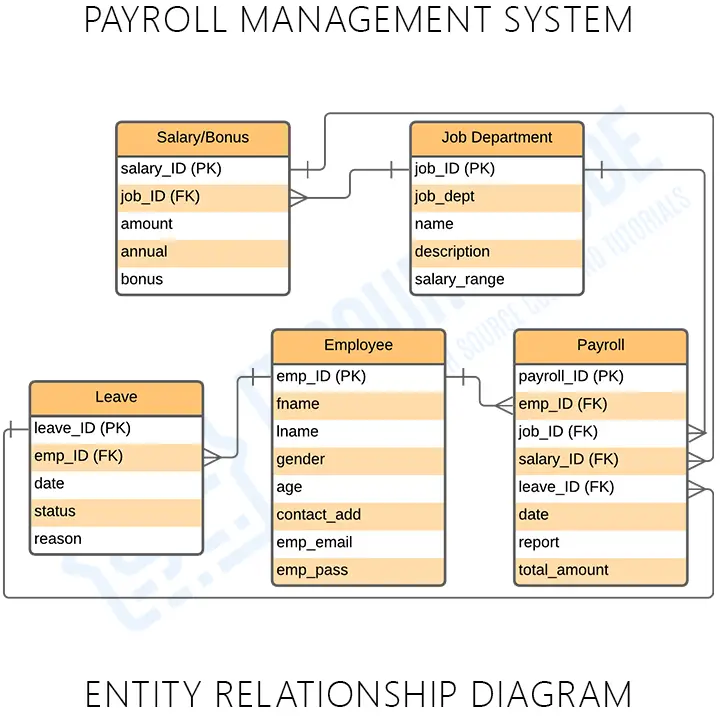This template is an ER diagram for employee payroll management system. It makes it easy for the business to manage the distribution of employees through the management system. As the name suggests, an ER diagram for an employee payroll management system shows the connection between two or more entities.
This includes real-world objects and database data. In software development, the model creates the database’s logical structure and connectivity. Employee Management Systems, Employee Information Systems, and Staff Management Systems are involved.
Payroll, salary, employees, evaluations, working points, and payments make up the payroll management system. Check out the related and suggested articles below to learn more about ER Diagrams and other things.
ER Diagram for Payroll Management System: Details
The table shows the overall description of the ER Diagram for the Payroll Management Management System. It has a complete overview of the project’s information.
| Name: | Payroll Management Management System ER Diagram |
| Abstract: | The payroll management system ER diagram depicts the relationship between various entities. It can be thought of as a blueprint for your system (project) structure. |
| Diagram: | ER Diagram is also known as Entity Relationship Diagram |
| Tools Used: | Diagraming tools that provide ER diagram symbols. |
| Users: | Company or Business Owners and Employees. |
| Designer: | ITSourceCode.com |
What is Payroll Management System?
Everything connected to paying employees and filing employment taxes is handled by payroll systems. This system is used to measure hours worked and compute earnings.
Withhold taxes and other deductions, print and deliver checks, and pay employment taxes to the government. The mentioned links in processes were the basis of the UML deployment diagram.
Payroll Management System Features
- Payroll Management: Payroll Management is the key feature of this system, and the ER diagram gives the relevant details. This basic information was composed of employee job info and status. This will also monitor or check on the leave and bonuses that the employee deserves, aside from the salary.
- Employee Management: This feature plays a big role in the system because it gathers important information about the employees. This information was used to keep track of how well they did their jobs and other important system issues.
- Manage Salaries and Bonuses: The admin will manage salaries and bonuses to track earnings and expenses. This method will help them update the payroll status for salaries and other personnel problems.
- Manage Job Status and Calculate Expenses: Its features will manage and monitor each employee’s job status. Then they will calculate their salaries for the range of their labor or per month. This will also keep track of all the business’s costs and save them to the database so they can be used for future inventory.
What is an ER Diagram?
The Entity Relationship Diagram, also called ERD, ER Diagram, or ER Model, is a type of structural diagram used in database design.
An ERD uses different symbols and lines to show two important pieces of information. The main parts of the system and how they connect to each other.
Why Do You Need an ER Diagram?
An ER diagram, which stands for entity-relationship diagram, is essential for modeling the data in a database. It is the main plan for how a database is put together.
ER diagrams show the entities and their attributes, which are the types of data that will be stored. They also show how one thing is connected to another.
ER Diagram for Payroll Management System
The ER Diagram of the Payroll Management System shows the system entity relationships in each entity. There is a function in each relationship.
Sample ER Diagram for Payroll Management System Project

Payroll Management System ER Diagram Tables
These tables below provide the complete database table details such as field names, descriptions, data types, and character lengths. Each of these tables represents the characteristics and attributes of data storage.
Table Name: Employee
| Field | Description | Type | Length |
| emp_ID (PK) | Employee ID | Int | 11 |
| fname | Employee First Name | Varchar | 255 |
| lname | Employee Last Name | Varchar | 255 |
| gender | Employee Gender | Int | 11 |
| age | Employee Age | Int | 11 |
| contact_add | Contact Address | Int | 11 |
| emp_email | Employee Email | Varchar | 255 |
| emp_pass | Employee Password | Varchar | 255 |
Table Name: Users
| Field | Description | Type | Length |
| admin_ID (PK) | Admin ID | Int | 11 |
| fname | Instructor First Name | Varchar | 255 |
| lname | Instructor Last Name | Varchar | 255 |
| gender | Instructor Gender | Int | 11 |
| age | Instructor Age | Int | 11 |
| contact_add | Contact Address | Int | 11 |
| admin_email | Admin Email | Varchar | 255 |
| admin_pass | Admin Password | Varchar | 255 |
Table Name: Job Department
| Field | Description | Type | Length |
| job_ID (PK) | Job ID | Int | 11 |
| job_dept | Job Department | Varchar | 30 |
| name | Job Name | Varchar | 30 |
| description | Job Description | Varchar | 30 |
| salary_range | Salary Range | Varchar | 30 |
Table Name: Salary or Bonus
| Field | Description | Type | Length |
| salary_ID (PK) | Salary ID | Int | 11 |
| job_ID (FK) | Job ID | Int | 11 |
| amount | Amount | Int | 11 |
| annual | Annual Expense | Date | |
| bonus | Bonus | Date |
Table Name: Leave
| Field | Description | Type | Length |
| leave_ID (PK) | Leave ID | Int | 11 |
| emp_ID (FK) | Employee ID | Int | 11 |
| date | Date | Date | |
| status | Leave Status | Varchar | 30 |
| reason | Reason for Leave | Text |
Table Name: Payroll
| Field | Description | Type | Length |
| payroll_ID (PK) | Payroll ID | Int | 11 |
| emp_ID (FK) | Employee ID | Int | 11 |
| job_ID (FK) | Job ID | Int | 11 |
| salary_ID (FK) | Salary ID | Int | 11 |
| leave_ID (FK) | Leave ID | Int | 11 |
| date | Date of Payroll Report | Date | |
| report | Report | Text | |
| total amount | Total Amount | Int | 11 |
Payroll Management System ER Diagram [PDF]
The ER Diagram for Payroll Management System in DBMS Pdf provides information explaining the concepts of the project database. You may apply this information to your capstone project. You can also use it as is or change its content to fit the needs of your project.
How to create an Entity-Relationship (ER) Diagram
Time needed: 5 minutes
Here are the steps on how to build Payroll Management System ER Diagram with Cardinality Ratio.
- Step 1: Become acquainted with the ER Diagram (Entity Relationship Diagram). Symbols and Cardinality
The Entity Relationship Diagram shows the structure of data types in a project. It uses symbols to clarify its parts and relationships. Their symbols and applications must be familiar before you build the ER Diagram.
ER Diagram Symbols:
Fields are the parts of a table that define the entity’s characteristics. In the database that the ERD models, attributes are commonly thought of as rows.
Keys are a technique to categorize data quality. It is used to organize ER diagrams and assist users in modeling their databases to ensure that they are efficient. This is also used to connect different tables in a database.
A primary key identifies a single entity instance, which means a unique attribute or set of attributes.
A foreign key is produced when data attributes have one too many relationships with other entities. - Step 2: Complete the entities that will be included.
Begin designing your ER Diagram by finalizing your railway reservation system’s entities. These are rectangles. You must leave room in future phases so they can be incorporated.
- Step 3: Add the attributes of each entity
Upon finalizing the entities, analyze their attributes. As characteristics, ER diagram entities are described. All these are characteristics. Multivalued characteristics have several values.
- Step 4: Describe the relationships (cardinality) between entities and attributes
Entities, characteristics, and relationships are needed to draw ERD relationships. The data structure and entity relationship diagram are based on evaluated information.
Conclusion:
The Payroll Management System was designed and built with the help of several diagrams, including the ER (entity-relationship) diagram. Each diagram you make and design will help you explain your ideas and show off your skills.
By making the ER diagram, you’ll be able to see the back end of the software. Where all the data that will enter and leave the system will be stored.
Inquiries
If you have any inquiries or suggestions about the Payroll Management System ER Diagram, just leave us your comments below. We would be glad to know your concerns and suggestions and be part of your learning.
Keep us updated and Good day!


Please what is the relationship between payroll entity and employee entity.